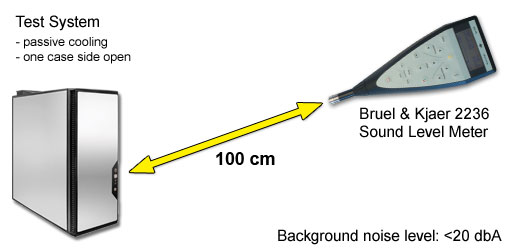 36
36
MSI GTX 770 TwinFrozr Gaming 2 GB Review
Performance Summary »Fan Noise
In past years, gamers would accept everything for a little bit more performance. Nowadays, users are more aware of the fan noise and the power consumption of their graphics cards.In order to properly test the fan noise that a card emits, we use the Bruel & Kjaer 2236 sound-level meter (~$4,000). It has the measurement range and the accuracy we are looking for.

The tested graphics card was installed in a system that was completely cooled passively. That is, passive PSU, passive CPU cooler, and passive cooling on the motherboard and on a solid state drive. Noise results of other cards on this page are measurements of the respective reference design.
This setup allows us to eliminate secondary noise sources and test only the video card. To be more compliant with standards like DIN 45635 (we are not claiming to be fully DIN 45635 certified), the measurement was conducted at a distance of 100 cm and 160 cm off the floor. The ambient background noise level in the room was well below 20 dBA for all measurements. Please note that the dBA scale is not linear but logarithmic. 40 dBA is not twice as loud as 20 dBA. A 3 dBA increase results in double the sound pressure. The human hearing perception is a bit different, and it is generally accepted that a 10 dBA increase doubles the perceived sound level. The 3D load noise levels were tested with a stressful game, not with Furmark.
MSI did a fantastic job with the noise levels of their GTX 770 Gaming. In idle, the card is almost inaudible on an open bench in a quiet room with no other fans. It will certainly be inaudible in a modern case with other fans present.
During gaming, the fan ramps up just a little bit to handle the increased thermal load, but it doesn't get noisy at all. Especially the gaming-noise levels are impressive--much better than any other custom design GTX 770 we've reviewed so far.
Even with such a quiet fan, the card stays below 79°C under load, which prevents any of NVIDIA's additional throttling at 80°C.


Jan 23rd, 2025 19:29 EST
change timezone
Latest GPU Drivers
New Forum Posts
- 12700K vs 245K (40)
- TPU's Nostalgic Hardware Club (19832)
- for those who think 12gb vram can max out everything (121)
- The coffee and tea appreciation thread (148)
- The TPU UK Clubhouse (25661)
- What do you do for a living? (420)
- Free Games Thread (4400)
- TECHPOWERUP HWBOT Contest Submissions List (31)
- RX580 not stable... (19)
- Ryzen 7600 ram 64gb vs 2 /4 channel,vs higher speed (78)
Popular Reviews
- NVIDIA GeForce RTX 5090 Founders Edition Review - The New Flagship
- NVIDIA GeForce RTX 5090 Founders Edition Unboxing
- NVIDIA GeForce RTX 5090 PCI-Express Scaling
- Alphacool Apex 1 CPU Water Block Review - Performance King!
- NZXT C1500 Review
- Pwnage StormBreaker Max CF Review
- PowerColor Alphyn AH10 Review
- AMD Ryzen 7 9800X3D Review - The Best Gaming Processor
- Montech Heritage Pro Review - The Leather Case
- NVIDIA GeForce RTX 50 Technical Deep Dive
Controversial News Posts
- NVIDIA 2025 International CES Keynote: Liveblog (470)
- AMD Debuts Radeon RX 9070 XT and RX 9070 Powered by RDNA 4, and FSR 4 (349)
- AMD Radeon RX 9070 XT & RX 9070 Custom Models In Stock at European Stores (226)
- NVIDIA GeForce RTX 5090 Features 575 W TDP, RTX 5080 Carries 360 W TDP (217)
- AMD Radeon RX 9070 XT Alleged Benchmark Leaks, Underwhelming Performance (204)
- AMD is Taking Time with Radeon RX 9000 to Optimize Software and FSR 4 (192)
- AMD's Radeon RX 9070 Launch Faces Pricing Hurdles (175)
- Potential RTX 5090 and RTX 5080 Pricing in China Leaks (173)
